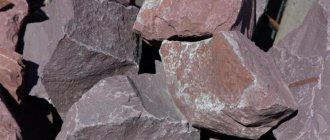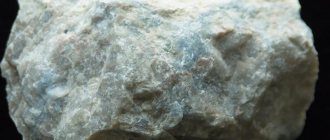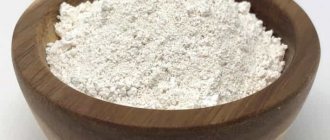What is bauxite
The stone was discovered in France in 1821. A useful discovery was made by Pierre Berthier, a French mineralogist and geologist. The name was given in honor of the village next door - Les Baux.
A small piece of bauxite was presented at the Paris Exhibition in 1855. The sign said "clay silver." Since then, the stone has been actively studied. The researchers clarified the chemical formula, described the physical properties and other characteristics.
Compound
Bauxite is an ore that consists of oxides of aluminum, silicon, iron and other substances. Some classify the rock as a mineral. The formula for bauxite shows that there is a lot of aluminum hydroxide. Industrialists are usually interested in alumina. Sometimes its content in this breed is up to 40–60% or more.
The formula of bauxite in chemistry is Al2O3*xH2O. The composition is very different. Here they find up to 100 elements from the periodic table.
The main “component” of the mineral is aluminum hydroxide.
The more it is, the more valuable the stone is for industry. The amount of silica and other numerous impurities are taken into account: silicates, carbonates, potassium and others. It is important how easy it is to separate alumina and aluminum oxide from the rock. This characteristic is called openability.
Other properties of bauxite:
- Specific gravity varies greatly depending on the location of extraction. For example, if the composition contains a lot of silica, this value is about 1.2 g/cm³. The specific gravity of dense samples, which contain more iron, is already approximately 2.8 g/cm³.
- The hardness of bauxite also varies greatly: from 2 to 7 on the Mohs scale.
- The rock often resembles clay. However, this impression is deceptive. The mineral, upon contact with water, does not turn into a flexible mass such as plasticine. There is also a lot of aluminum in clay, but there it is in a different form.
- Cleavage is absent.
- There is no syngony, that is, the mineral is amorphous.
- Structure may vary. There are stones with large pores and dense, hard specimens.
- Dim, low shine.
- Opacity.
- Density varies - from 2.5 to 3.5 g/cm.
Bauxite contains diaspores. These are hard stones: 6.5–7 on the Mohs scale. Such rocks are used to produce aluminum. There is a lot of Al2O3 in the diaspora - about 85%.
Value
Explored mineral deposits are not always developed. Sometimes the ore does not have suitable characteristics or development is not economically feasible. Before mining, the quality and value of the rock is assessed. The samples determine, for example, the following:
- A form of aluminum hydroxide.
- The composition of various impurities and the proportion of each of them. Valuable bauxite is one that contains a lot of alumina and silica.
- Openability - ease of obtaining aluminum oxide. This simplifies the work, makes it cheaper and more profitable.
It is not possible to determine the quality of a mineral by appearance. It's changing too quickly. The value will be determined after examination in the laboratory.
Appearance
Bauxite looks different. Sometimes they resemble clay, hard stone, or something in between. There are other appearance features:
- There are porous and denser specimens.
- There are stones with inclusions. The latter are small round bodies made of alumina and iron.
- The color varies, which is explained by the rich composition. Bauxites are found with colors ranging from white to dark red. Most minerals are brown or brick-colored.
Production
Almost all known deposits of this stone are concentrated in 18 countries. There are two types of deposits. Depending on the origin there are:
- Residual chemogenic. Here the rock, which contains a lot of aluminum, has been “processed” by nature for a long time. It was subjected to chemical action (lateralization) and weathering in a hot climate. The result was ore. Most of the deposits in the world are just like this. Due to their composition, bauxite from sedimentary deposits produces aluminum oxide more easily and is considered to be of higher quality.
- Sedimentary-chemogenic. Here bauxite appears from the products of mechanical and chemical weathering. They are found in pits of different nature. Stones in such deposits often occur in layers. The mineral in each of them differs in quality. In some layers, bauxite is replaced by clay. The openability of such stones is worse, and enrichment is more difficult.
Bauxite is usually mined by open-pit mining. Underground mining is rarely used. The strata sometimes lie at the bottom of the sea.
Bauxite
In 1821, the French chemist Faithful first examined and described a rock found near the city of Les Baux, in the south of France, containing 52% Al2O3, 27.6% F2O3 and 20.4% H2O, and named it after its place finding bauxite.
Currently, bauxite is the most important aluminum ore, on which, with few exceptions, almost the entire world aluminum industry is based.
Bauxite is a complex rock, which includes: aluminum oxide hydrates, forming the main ore mass; iron in the form of oxide hydrates, oxides and silicates; silicon, in the form of quartz, opal and kaolinite; titanium, in the form of rutile and other compounds; calcium and magnesium carbonate, as well as small amounts of compounds of sodium, potassium, zirconium, chromium, phosphorus, vanadium, gallium and other elements; Often an admixture of pyrite is also found in bauxite.
The chemical composition of bauxite, depending on the mineralogical form of aluminum hydroxide and the amount of impurities, varies widely. The quality of bauxite as an aluminum ore is determined primarily by the content of alumina and silica in them: the lower the content of SiO2 and the higher the Al2Oz, the higher the quality of the ore, other things being equal. Of great importance is the so-called “breakability” of bauxite, i.e., the ease of extraction from alumina. The physical properties of bauxite are very diverse, and external differences are so variable that identifying bauxite by eye is very difficult. This causes great difficulties in searching for bauxite. Characterized by an extremely large dispersion of bauxite components. Therefore, under a conventional microscope, only isolated, well-crystallized precipitates and impurities can be distinguished in bauxite.
In appearance, bauxite (is a clay-like, and often stony rock; in general, their structure is very diverse. Bauxite (can be dense, with an earthy fracture, or porous, with a rough cellular fracture; often rounded bodies are included in the bulk of bauxite, giving an oolitic structure ore These bodies are formed by iron oxides and sometimes alumina.
The color of bauxite is as varied as its structure. Bauxite comes in all sorts of shades - from white to dark red, but most often it is brown or brick-red in color. The specific gravity of bauxite varies widely. For light porous bauxites with low silica and iron contents, it is approximately 1.2; Dense, highly ferruginous, stony bauxites have a specific gravity of approximately 2.8. The hardness of bauxite on the Mohs scale varies from 2 to 7. Although sometimes resembling clay in appearance, bauxite has nothing in common, however, it has nothing in common with it. A characteristic feature of bauxite is that, unlike clays, it does not produce a plastic mass with water.
The mineralogical difference between bauxite and clay, as mentioned above, is that in the former, aluminum is in the form of hydroxides, and in the latter, in the form of kaolinite. Depending on the mineralogical form of boehmite hydroxide and diaspore AlOOH or hydrargillite Al(OH)3, in the form of which aluminum is found in bauxite, the types of bauxite are distinguished accordingly: boehmite, diaspore, hydrargillite and mixed.
To study the mineral composition of bauxite, it is very convenient to use thermal analysis to obtain heating curves.
In Fig. 1 shows the results of thermal analysis of various samples of Tikhvin bauxites, performed by academician. N. S. Kurnakov and G. G. Urazov. A number of endothermic sections (stops) are visible on the heating curves, which correspond to the dehydration of hydrargillite, diaspore (boehmite), and kaolinite. The thermal stop, corresponding to the dehydration of hydrargillite, lies in the range of 202-205°, diaspora - 509-555° and kaolinite - 558-605°
rice. 1. Heating curves of Tikhvin bauxites (according to N. Kurnakov and G. Urazov)
a, b, c - endothermic stops corresponding to the release of water from hydrargillite - АІ2О3*ЗН2О, diaspora - АІ2О3*Н2О and kaolinite - АІ2О3*2SiO2*ЗН2О; d - spontaneous heating, characteristic of molecular transformation in dehydrated kaolin in the region of 960-1000 °
In Fig. 2. Similar heating curves for bauxites of the Northern Urals (the “Red Riding Hood” deposit) are presented, indicating their diasporic (boehmite) nature.
rice. 2. Heating curves of bauxite from the “Little Red Riding Hood” deposit (according to Maldavantsev)
Horizontal sections on the curves (endothermic stops) correspond to the release of water from the diaspore (boehmite)—АІ2О3*Н2О
By thermal analysis, the mineralogical form in which alumina is present in bauxite, and therefore the type of the latter, can easily be established.
Even though bauxite has been known for over 100 years; and in recent decades it has attracted exceptional attention as the most valuable aluminum ore. their genesis (origin) cannot yet be considered clarified. There is no unity of opinion among geologists and geochemists on this issue. There is, however, a lot of data indicating that the formation of bauxite is generally associated with different processes and therefore cannot be uniform for all deposits. There are three major hypotheses regarding the genesis of bauxites:
1) bauxite is the residue after the dissolution (leaching) of limestones by the so-called terro rossa (red earth), which consists of a mixture of various hydrous aluminosilicates (Fox);
2) bauxites are a product of weathering of ancient crust with subsequent mechanical movement and redeposition of the residual product, which is in a colloidal state (S. F. Malyavkin);
3) bauxite is a chemical precipitate formed during the decomposition of solutions of aluminum, iron and titanium salts (obtained by leaching of igneous rocks with natural waters) at the moment they enter reservoirs - seas and lakes (Academician A. D. Arkhangelsky).
The main types of bauxite, at least in the CIS, were formed precisely in the latter way by Acad. A.E. Fersman gives the following scheme for the precipitation of aluminum oxide hydrates from solutions of aluminum salts at different pH values, illustrating the possibility of hydrochemical formation of aluminum accumulations (in the form of hydrates):
| pH below 4 | pH = 4-7 | pH =7-11 | pH = 13-14 |
| Aluminum dissolves (Aluminum as a cation) | Aluminum is deposited | Aluminum remains in sediment | Aluminum dissolves (Aluminum as an anion) |
From this diagram it can be seen that aluminum dissolves only at very high and at very low pH. The first rarely occurs in the earth's crust; much more important is the second group of solutions - acidic ones, in the form of which aluminum migrates (carried out) very easily. The places where such solutions are formed are, for example, areas of sulfide oxidation. These solutions can lead to the precipitation of aluminum hydroxide when the pH increases, which occurs if they enter the ocean environment of a sea or lake with a pH of 6-8.
Due to this, the distribution of bauxites should be primarily associated with coastal sediments of ancient (Paleozoic and Mesozoic) seas or lakes. In the CIS, such areas are both slopes of the Ural ridge and the territory of Central Asia.
Bauxite is a fairly widespread rock. The world's proven reserves are estimated at approximately one billion tons, with Europe taking first place in terms of reserves, Africa second, America third, Asia fourth and, finally, Australia fifth.
The development of bauxite for industrial purposes began relatively recently. Bauxite was first mined in France in the 70s of the last century. In 1890, bauxite development began in England and the USA, in 1/907 in Italy, in 1908 in India and Dutch Guiana.
The world's largest bauxite deposits are concentrated in the southeast of France, in the Var department, near the city of Beau. French bauxite is considered the best in the world. The bauxites of the Var department belong to the boehmite-diasporic type. Of the other Western European countries, the most important bauxite deposits are located in Hungary, Yugoslavia (in Dalmatia), Italy (on the Istrian Peninsula) and Greece. England, Switzerland and Norway do not have their own bauxites and import them from other countries.
In the USA, the most important deposits are located in Arkansas. A distinctive feature of these bauxites is that they belong to the three-type hydrargillite type and have low iron content.
In South America, significant bauxite deposits are located in British and Dutch Guiana. In 1916, bauxite deposits were discovered in Africa in the Gold Coast region. A special feature of these bauxites is that they contain small amounts of gold and silver. In India, bauxite deposits are located in inaccessible areas, and their industrial significance is still small.
Table 3 shows the chemical composition of bauxite from the most famous deposits in various countries.
| Components % | France (Var department) | Hungary | Yugoslavia | Greece | Italy | USA (Arkansas) | Dutch Guiana | British Guiana |
| Al2O3 | 57-62 | 57-62 | 48-54 | 56-59 | 54-58 | 57-60 | 60-61 | 59-60 |
| SiO2 | 3-5 | 2-7 | 1-4 | 3-7 | 2-4 | 4-7 | 2-2,5 | 1,5-2 |
| Fe2O3 | 18-26 | 12-20 | 20-24 | 16-21 | 22-26 | 2-7 | 2,5-3 | 5-6 |
| TiO2 | 3-4 | 2,5-3,5 | 2,5-3,5 | 2-2,5 | 2-3 | 2,5-3,5 | 2,5-3 | 2-2,5 |
| H2O | 10-12 | 14-16 | 18-24 | 13-16 | 12-15 | 28-30 | 29-31 | 29-30 |
The main industrial deposits of bauxite in our country are concentrated in two areas - the Tikhvin district of the Leningrad region and in the Urals.
Bauxite deposits in the Tikhvin region were discovered in 1916. Their formation dates back to the Carboniferous period. Tikhvin bauxites occupy a narrow strip 6–12 km wide. They usually occur in the form of irregularly shaped nests (lenses) and are covered on top with sandy and clayey rocks of glacial origin. In appearance, Tikhvin bauxites are extremely diverse: their color goes through all shades - from white to red and purple; their specific gravity and chemical composition are also variable.
The chemical composition of Tikhvin bauxites varies from such rocks, the ratio between the content of alumina and silica in which corresponds to clays, to such ores, where the amount of alumina reaches 70%, a) the SiO2 content drops to 2-2.5%. The amount of chemically bound water in the bulk of bauxite is in the range of 12-14%, but there are also bauxites that contain up to 20% H20. The TiO2 content usually does not exceed 2.5-3.0%. As for Fe2O3, its amount varies greatly: from 3-5% in white bauxites to 30% in highly ferruginous (usually powdery) bauxites. Some varieties of Tikhvin bauxites contain CaO, as well as chromium compounds, the content of which reaches 0.2%.
The approximate average chemical composition of bauxite throughout the Tikhvin deposit is characterized by the following figures:
47.7% Al2O3; 17.2 Fe2O3; 13.2% SiO2; 2.6% TiO2; 3.9% CaO and 15.4% H20.
Aluminum oxide hydrate is found in them mainly in the form of boehmite (and in a much smaller amount - in the form of hydrargillite. In addition to iron and silica oxides, the most important impurities in Tikhvin bauxites are kaolinite and calcite. Titanium oxide is present in them in the form of small crystals of the mineral rutile.
The increased silica content in Tikhvin bauxites reduces the quality of their aluminum ore.
The most important Ural bauxite deposits are concentrated in the Northern Urals in the region of the village of Serov, in the Middle Urals in the region of Kamensk and in the Southern Urals in the Satka region of the Chelyabinsk region and the Maloyazovsky region of the Bashkir Republic.
In the Northern Urals, bauxites, discovered in 1931, include a number of deposits, the most explored of which are “Little Red Riding Hood”, Bogoslovskoye and Ivdelskoye. The formation of North Ural bauxites dates back to Paleozoic times. They occur among limestones, and the main mass of them is dense rock brown-red color of oolitic structure; less common is the flagstone variety of bauxite, which in appearance resembles jasper.
The layered nature of the deposits and the presence of coral skeletons in them suggest (Academician A.D. Arkhangelsky) that the bauxites of the Northern Urals were formed by chemical precipitation of hydrates from aqueous salt solutions to the bottom of the ancient sea. Due to the high content of Al2O3 and a small amount of SiO2 impurities, these bauxites can be compared to the best varieties of French bauxites. The bauxites from the “Red Riding Hood” deposit are of especially good quality. On average, the chemical composition of bauxite from this deposit can be characterized by the following figures:
56% Al2O3; 25 Fe2O3; 3.5% SiO2; 2.2% TiO2 and 11% H20.
Mineralogically, the bauxites of the Northern Urals are a rock of the diasporic-boehmite type. Iron is present in them mainly in the form of anhydrous hematite Fe2O3; silica is partly in a free state in the form of quartz and gel (opal), and partly in a bound form, in the form of chamoisite (3H20 * 3FeO * 3Al2O3 * 2SiO2, finally, titanium - in the form of rutile crystals, as well as in the form of a gel.
According to geologist N. A. Arkhangelsky, the mineralogical composition of bauxites from the “Red Cap” deposit can be presented as follows (in%):
| Diaspore and boehmite AlOOH | 62,4 |
| Hematite Fe2O3 | 20,7 |
| Chamoisite 3H20*3FeO*3Al2O3*2SiO2 | 10,4 |
| Kaolinite Al2O3*2SiO2*2Н20 | 0,8 |
| Calcium and magnesium carbonates | 1,7 |
| The rest (pyrite, titanium mineral, phosphorite, etc.) | 4,0 |
| 100 |
Bauxites of the “Red Cap” deposit occur in the form of an inclined layer with a dip angle of 25–30°. The ore body consists of dense rocks that require blasting during mining.
Several bauxite deposits are known in the Middle Urals region. The most studied is the Sokolovskoye deposit (Kamensky district), discovered and explored in 1932-1933. The deposit is a sheet-like, almost horizontal bauxite deposit, covered with a layer of sediment up to 5 m thick. The formation of Sokolov bauxite dates back to Mesozoic time. Depending on the SiO2 content, Sokolovsky bauxites can be divided into two most important varieties, more or less closely mixed in the ore strata: stony bauxite, containing silica up to 3.7%, and earthy (loose) bauxite - up to 9%. The average chemical composition of Sokolovsky bauxites is presented as follows:
31.7% Al2O3; 38.3 Fe2O3; 5.8% SiO2; 4.5% TiO2; and 18, 19% H20.
The mineralogical composition of Sokolovsky bauxites (according to N.A. Arkhangelsky) can be characterized approximately as follows (in%):
| Hydrargillite Al(OH)3 | 51,9 |
| Hematite Fe2O3 | 29,9 |
| Kaolinite Al2O3*2SiO2*2Н20 | 7,1 |
| Opal SiO2 (gel) | 0,6 |
| Quartz SiO2 (crystalline) | 5,1 |
| The rest (pyrite, rutile, phosphorite and others) | 5,7 |
| 100 |
The fact that alumina in Sokolovsky bauxites is present in the form of hydrargillite is their positive feature, since the latter is more chemically active than diaspore or boehmite.
This circumstance, as we will see below, facilitates the task of extracting alumina from such bauxite. However, the relatively low content of A1203 and the high content in these bauxites make them less valuable compared to the bauxites of the Northern Urals.
Bauxite deposits in the Southern Urals were discovered in October 1935. They represent a sheet-like deposit extending among limestones. The most common bauxites found here are marginal, flagstone and block jasper-shaped bauxites.
In terms of their mineralogical composition, South Ural bauxites belong to the boehmite (“Ivanov Log”) and diaspore (“Kukshik”) types. Their chemical composition is more or less homogeneous and is characterized by the following figures:
53-57% A1203; 18-23% Fe203; 5-7% SiO2 and 11-13% H20.
In the upper layer of the formation there are sometimes varieties of white bauxite containing up to 78% Al203 and only 0.4% SiO2.
The South Ural bauxite deposits should be classified as a first-class raw material base for our aluminum industry.
Main varieties
All bauxites have the same designation, although they are very different. Types are distinguished according to several characteristics:
- According to physical condition and density. There are earthy and clay-like, loose and hard. Some varieties have pores in their structure.
- There are stones of round shape and in the form of fragments.
- Some minerals have a more or less uniform structure, while others have noticeable layers.
- According to the nature of formation, they are divided into residual and sedimentary stones. This affects quality and suitability for production.
- By composition. It can be very different. They are divided into hydrargillite stones, boehmite stones, diasporic stones, and mixed stones. Varieties include, for example, nepheline-containing ore and alunites.
- Color: white, black, brown, green, gray.
The history of the discovery and why it is called that
The name of the ore is the same as the place where it was discovered. The composition is very diverse, but the main components are various aluminum oxide hydrates, iron-containing and silicon-containing substances. The chemical formula of bauxite does not reflect the entire composition, but it is used mainly in the aluminum industry as the main source of raw materials. The content of aluminum-containing substances can be 40-60% or more.
The dense mineral comes in a variety of shades, from red to green and gray. But you will never find transparent bauxite. More often it is dense and hard, sometimes it is found in the form of an earthy and loose substance. In this case, when touched, marks will remain on your hands.
Perhaps we would now call this mineral bertite if in 1821 a French geologist named Pierre Berthier had not become modest when he found an unusual find during his summer vacation. The rock he discovered was made of stone with unusual properties.
Berthier did not know that several decades would pass, and bauxite, whose formula is Al2O3xnH2O, would become a raw material, without which the aluminum industry would not develop at such a rapid pace. But what happened, happened. And the mineral is named after the Provençal village of Les Baux de Provence (spelled Les Baux in French).
It took 30 years for the composition of the rock to be assessed by mineralogists of the time, but in the 50s bauxite took its place in the Paris exhibition center, originally called “clay silver”. It looks very much like clay.
Features of processing
The quality of the stones, on which the processing method depends, is determined in the laboratory. The “silicon module” is calculated using the formula MSi = Al2O3/SiO2. Then do the following with the mined ore:
- Higher quality bauxites (with high results) are processed using the Bayer method. As a result, alumina becomes sodium aluminate. Next, the resulting solution is cleaned of red mud. The alumina precipitates and is leached. The output is aluminum.
- For the rest, the sintering method is used. The treatment is carried out at high temperature: +1250 °C. Special rotary kilns are used. Crushed bauxite, soda and limestone are thrown there. All this is sintered and then leached. Aluminum hydroxide is precipitated and filtered.
Bauxite deposits
According to modern data, the main reserves of bauxite (up to 90%) are located in 18 countries. The most important are:
- The country that ranks first in rock reserves (20 billion tons) is Guinea.
- Australia ranks second in the world (7 billion tons).
- Third place (6 billion tons) – Brazil.
- Fourth place (3 billion tons) – Vietnam.
- Fifth place (2.5 billion tons) – India and Indonesia.
Smaller volumes are mined in Jamaica, Mali, and Cameroon.
Bauxite mining is carried out in some regions of Russia:
- Arkhangelsk;
- Sverdlovsk;
- Belgorodskaya;
- Leningradskaya;
- Komi Republic.
But Russian reserves are minimal (250 million tons - about 1% of world production) and are imported. Some CIS countries also mine rock. Mining is carried out in Uzbekistan and Azerbaijan. But stocks are also minimal.
Watch a video about the deposit in the Komi Republic:
World bauxite reserves
In 1974, there were approximately 19 billion tons of this ore on Earth. True, the scientists’ assessment had errors, since it did not include the huge Soviet Union. At that time, there were only 5.2 billion tons of reliable proven reserves.
In the first decades of the last century, almost all bauxite was mined in developed countries. And today work is underway there, for example, in Italy and France. Although there is little stone in Europe - a maximum of 7% of world reserves. These minerals are also scarce in the United States.
In the 60s, states from the Caribbean Sea became leaders: Guyana, Jamaica, Suriname. Today, the main countries in production are Guinea, Australia, Brazil and some other countries. There are bauxites in Russia too. Deposits have been discovered, for example, in the Urals and the Komi Republic.
Properties
As already mentioned, the composition of the mineral is very diverse, which greatly affects its properties. But some physical properties can be distinguished:
- colors - you can find all shades of red (from light pink to dark red), green (from gray-green to grassy) and gray (from light tones, including white to dark gray almost black);
- the condition can also be different: they distinguish rocky, porous, loose, earthy and clay-like;
- density directly depends on the amount of iron-containing substances and varies from 1.8 to 3.2 g/cm3;
- maximum hardness is 6 on the Mohs scale;
- opaque.
For the industry, there is one chemical trait that is most important - "breakability", meaning whether it is easy enough to extract the aluminum oxides from this ore.
Areas of application of the mineral
This is a valuable raw material for industry. Alumina is obtained from bauxite. It is used in different ways, for example, they do the following:
- Molding material.
- Flux for ferrous metallurgy.
- High-quality refractories that are not afraid of temperatures or loads.
- Special dense cement with excellent physical properties. The solution hardens quickly and bonds perfectly to the reinforcement. The resulting concrete is resistant to high temperatures and acidic environments.
- Alumina is ground and used in the production of anti-oil spill products.
- Pure aluminum for various products.
Bauxite has also been used in other areas. From them we get:
- electrocorundum is an excellent jet abrasive for industry;
- metal compounds for the production of pigments.
Bauxite is a valuable find for humanity. The ore is used in the chemical industry, construction, and metallurgy. The world's reserves will last for a long time. Due to its use in the military-industrial sector, the breed is considered strategically important.
Applications of bauxite
In the global metallurgical industry, bauxite is the main raw material for the smelting of aluminum, which is used in almost all spheres of the national economy. In the chemical industry, stone acts as a filler in paint and varnish compositions and sorbents that purify petroleum products from foreign impurities.
In ferrous metallurgy, the rock is used in the smelting of alloys in the form of fluxes. Bauxite, melted in an electric furnace, is converted into electrocorundum, which is subsequently used in the production of artificial abrasive materials.
The main chemical component of bauxite is alumina, which is extracted from the rock and is widely used in the production of building mixtures. Aluminous cement is made from it - a fast-hardening composition, which, due to its high binding properties, is most effective when carrying out construction in low temperatures, as well as carrying out emergency work in a short time. Bauxite rocks with a small amount of iron in their composition, resistant to temperatures of 1700-1900 ° C, are used in the production of high-alumina refractories.
Bauxites are not credited with healing or supernatural properties, so they are not used in lithotherapy and magical rituals.
The stone is not of particular interest to jewelers, and in jewelry it can only be found in the form of designer handmade items. It is also used to make souvenirs, in particular, beautiful polished balls on a stand.
Rock processing
Rock is mined in two main ways:
Processing of high-quality rock is carried out chemically using the Bayer process:
- When crushed bauxite is treated with sodium hydroxide, sodium aluminate is formed.
- The resulting compound in liquid form is purified from unnecessary impurities.
- Then aluminum hydroxide (alumina) is precipitated from it.
Low-quality crushed rocks are processed in another way (electrolysis):
- The crushed raw materials are combined with soda and limestone.
- Sent to a special rotary kiln.
- The workpiece removed from the furnace is treated with alkali. A chemical reaction occurs with the precipitation of hydroxide.
- The hydroxide is separated and then filtered.
The designation of bauxite on the map looks like a black square with an inscribed white circle. This is how all types of aluminum ore are designated.
Video review on the topic of aluminum mining and processing:






